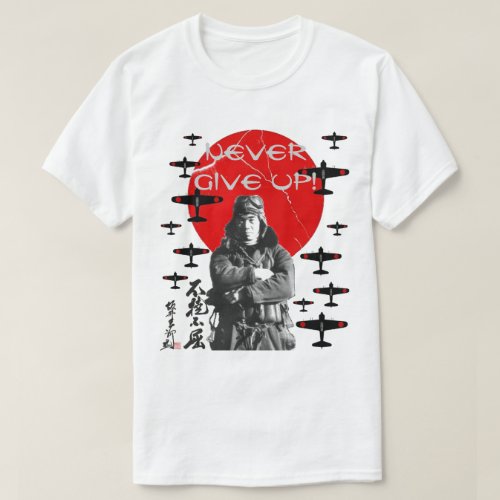SABURO SAKAI T-Shirt



Saburō Sakai was born on August 25, 1916, in Saga, Japan, into a family of samurai ancestry whose ancestors had taken part in the Japanese invasions of Korea but who were forced to make a living as farmers following haihan-chiken in 1871. Sakai, the third born of four sons (his given name literally means "third son"), had three sisters. Saburō was 11 when his father died, leaving Saburō's mother alone to raise seven children. With limited resources, Sakai was adopted by his maternal uncle, who financed his education in a Tokyo high school. However, Sakai failed to do well in his studies and was sent back to Saga after his second year. With no other options, on May 31, 1933 at the age of 16, Sakai enlisted in the Japanese Navy as a Sailor Fourth Class (Seaman Recruit) (四等水兵). Saburō Sakai describes his experiences as a naval recruit:[1] "The petty officers would not hesitate to administer the severest beatings to recruits they felt deserving of punishment. Whenever I committed a breach of discipline or an error in training, I was dragged physically from my cot by a petty officer. 'Stand tall to the wall! Bend down, Recruit Sakai!' he would roar. 'I am not doing this because I hate you, but because I like you and want you to make a good seaman. Bend down!' And with that he would swing a large stick of wood and with every ounce of strength he possessed would slam it against my upturned bottom. The pain was terrible, the force of the blows unremitting." After completing his training the following year, Sakai was graduated as a Sailor Third Class (Ordinary Seaman) (三等水兵). Sakai then served aboard the battleship Kirishima for one year. In 1935, he successfully passed the competitive examinations for the Naval Gunners School. Sakai was promoted to Sailor Second Class (Able Seaman) (二等水兵) in 1936, and served on the battleship Haruna as a turret gunner. He received successive promotions to Sailor First Class (Leading Seaman) (一等水兵) and to Petty Officer Third Class (三等兵曹). In early 1937, he applied for and was accepted into a pilot training school. He graduated first in his Naval Class at Tsuchiura in 1937, earning a silver watch presented to him by Emperor Hirohito himself. Sakai graduated as a carrier pilot, although he was never actually assigned to aircraft carrier duty. Promoted to Petty Officer Second Class (二等兵曹) in 1938, he first took part in aerial combat flying the Mitsubishi A5M in the beginning of the Second Sino-Japanese War in 1938-1939 and was wounded. Sakai shot down a Soviet built DB-3 bomber in October 1939. Later he was selected to fly the Mitsubishi A6M2 Zero fighter in combat over China. After the war, Sakai retired from the Navy. He became a Buddhist acolyte and vowed he would never again kill any living thing, not even a mosquito.[12] Sakai harbored no animosity toward those who had been "the enemy" during WW2, and urged others not to do so either. When asked about Japan's eventual surrender, he responded: "Had I been ordered to bomb Seattle or Los Angeles in order to end the war, I wouldn't have hesitated. So I perfectly understand why the Americans bombed Nagasaki and Hiroshima." Times were difficult for Sakai; finding a job was difficult for him because of conditions imposed by the Allies, and because of anti-military provisions placed into the new Japanese Constitution. He eventually started a successful printing shop, which he used to help his former comrades and their families with employment. Sakai's wife died in 1954[14] and he later remarried. He visited the U.S. and met many of his former adversaries, including the tail-gunner who had wounded him.[12] In 2000, Sakai served briefly as a consultant for the popular computer game Combat Flight Simulator 2. In his later years, Sakai was asked to appear as a motivational speaker at Japanese schools and corporations. His theme was always the same, the credo by which he lived his entire life: "Never give up." Sakai expressed concern for Japan's collective inability to accept responsibility for starting the war[citation needed], and over the popular sentiment that only the military — not the political leaders — were responsible. He decried the kamikaze campaign as brutally wasteful of young lives; Sakai also drew attention with his critical comments about Emperor Hirohito's role. "Who gave the orders for that stupid war?" he asked in an interview reported August 10, 2000, by The Associated Press. "The closer you get to the emperor, the fuzzier everything gets." Just months before he died, Sakai officially admitted to reporters that he still prayed for the souls of the airmen (Chinese, American, Australian and Dutch alike) he had killed in action. "I pray every day for the souls of my enemies as well as my comrades," he said. "We all did our best for our respective countries...Glorifying death was a mistake; because I survived, I was able to move on - to make friends in the U.S. and other countries." Saburo Sakai died of a heart attack in 2000, following a U.S. Navy formal dinner - where he had been an honored guest - at Atsugi Naval Air Station. He was 84. Sakai had sent his daughter to college in the United States "to learn English and democracy." There she married an American, and gave Saburo two American-born grandchildren. He is survived by all three.


